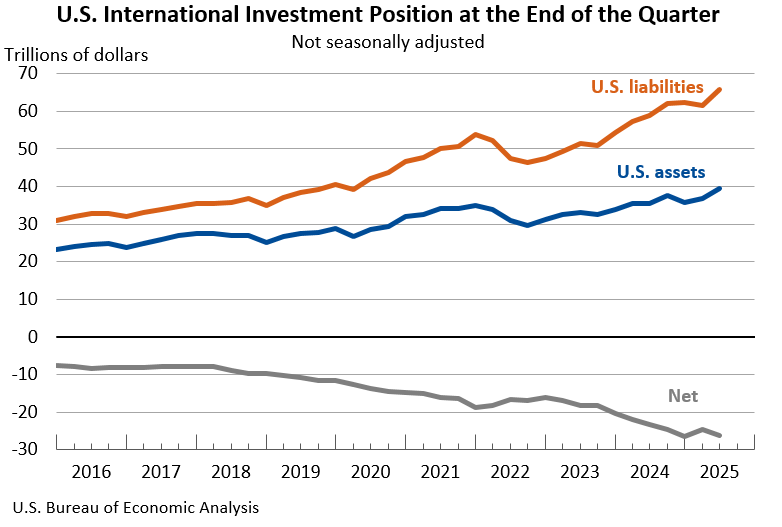Notice
Due to a lapse in appropriations, this website is not being updated.
Bureau of Economic Analysis
U.S. International Investment Position, 2nd Quarter 2025
The U.S. net international investment position, the difference between U.S. residents’ foreign financial assets and liabilities, was -$26.14 trillion at the end of the second quarter of 2025, according to statistics released today by the U.S. Bureau of Economic Analysis. Assets totaled $39.56 trillion, and liabilities were $65.71 trillion. At the end of the first quarter, the net investment position was -$24.65 trillion (revised).
Principal Federal Economic Indicators
Noteworthy
The Latest
U.S. International Transactions, 4th quarter and Year 2017
The U.S. current-account deficit increased to $128.2 billion (preliminary) in the fourth quarter of 2017 from $101.5 billion (revised) in the third quarter of 2017. As a percentage of U.S. GDP, the deficit increased to 2.6 percent from 2.1 percent. The previously published current-account deficit for the third quarter was $100.6 billion.
U.S. Current-Account Deficit Increases in Fourth Quarter 2017
The U.S. current-account deficit increased to $128.2 billion (preliminary) in the fourth quarter of 2017 from $101.5 billion (revised) in the third quarter of 2017. As a percentage of U.S. GDP, the deficit increased to 2.6 percent from 2.1 percent. The previously published current-account deficit for the third quarter was $100.6 billion.
Initial Estimates Show Digital Economy Accounted for 6.5 Percent of GDP in 2016
The Bureau of Economic Analysis released, for the first time, preliminary statistics and an accompanying report exploring the size and growth of the digital economy. Goods and services that are primarily digital accounted for 6.5 percent of the U.S. economy, or $1.2 trillion, in 2016, after a decade of growing faster than the U.S. economy overall, BEA’s research shows.
From 2006 to 2016, the digital economy grew at an average annual…
Initial Statistics on the Size and Growth of the Digital Economy to be Released Thursday
The Bureau of Economic Analysis will release, for the first time, preliminary statistics and an accompanying report exploring the size and growth of the digital economy at 10:30 a.m. on Thursday, March 15.
The report will be available at BEA’s website, www.bea.gov.
The report will include in its definition of the digital economy three major types of goods and services:
BEA Works with Partners to Understand Differences in Bilateral Trade Statistics
Trade statistics produced by the Bureau of Economic Analysis provide policymakers and other stakeholders with critical information for understanding the role of the United States in the global economy. As the size and complexity of international transactions have increased, BEA is working on a number of fronts to make its trade statistics even better.
January 2018 Trade Gap is $56.6 Billion
The U.S. monthly international trade deficit increased in January 2018 according to the U.S. Bureau of Economic Analysis and the U.S. Census Bureau. The deficit increased from $53.9 billion in December (revised) to $56.6 billion in January, as exports decreased more than imports. The previously published December deficit was $53.1 billion. The goods deficit increased $2.8 billion in January to $76.5 billion. The services surplus increased $0.…
U.S. International Trade in Goods and Services, January 2018
The U.S. monthly international trade deficit increased in January 2018 according to the U.S. Bureau of Economic Analysis and the U.S. Census Bureau. The deficit increased from $53.9 billion in December (revised) to $56.6 billion in January, as exports decreased more than imports. The previously published December deficit was $53.1 billion. The goods deficit increased $2.8 billion in January to $76.5 billion. The services surplus increased $0.1…
2017 Trade Gap is $568.4 Billion
The U.S. international trade deficit increased in 2017 according to the U.S. Bureau of Economic Analysis and the U.S. Census Bureau. The deficit increased from $504.8 billion in 2016 to $568.4 billion in 2017, as imports increased more than exports. As a percentage of U.S. gross domestic product, the goods and services deficit was 2.9 percent in 2017, up from 2.7 percent in 2016. The goods deficit increased from $752.5 billion in 2016 to $811…
New Arts and Culture Stats Zoom in on States
In the big picture, arts and culture account for 4.2 percent of the U.S. economy in the Bureau of Economic Analysis' latest statistics. Want to zoom in for a close-up? Now you can, using detailed data that are available for each state for the first time.
Arts and Cultural Production Satellite Account, U.S. and States 2015
The Arts and Cultural Production Satellite Account (ACPSA) released today by the U.S. Department of Commerce's Bureau of Economic Analysis (BEA) show that arts and cultural economic activity nationwide increased an inflation-adjusted 4.9 percent in 2015. That compares with a 0.4 percent increase in 2014 (table 1). Arts and cultural economic activity accounted for 4.2 percent of gross domestic product (GDP), or $763.6 billion, in 2015 (table…




